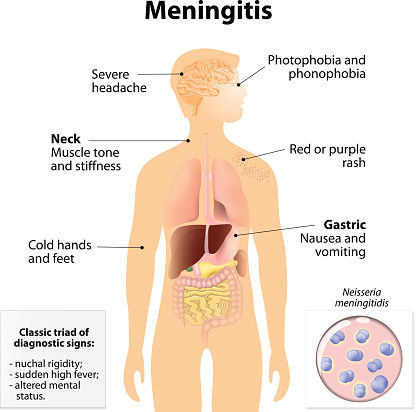A nurse in the emergency department is caring for a child who has a temperature of 39.1° C (102.4° F) and a suspected diagnosis of bacterial meningitis. Which of the following actions should the nurse take first?
Administer an antipyretic to the child.
Dim the lights in the child's room.
Implement droplet precautions for the child.
Prepare the child for a lumbar puncture.
The Correct Answer is C
A. "Administer an antipyretic to the child." While managing fever with antipyretics is important, it is not the immediate priority. Ensuring the child's safety and preventing the spread of infection are more urgent.
B. "Dim the lights in the child's room." While dimming the lights can help reduce discomfort and sensitivity in a child with meningitis, it is not the first priority. Implementing precautions and addressing infection control is more critical initially.
C. "Implement droplet precautions for the child." Bacterial meningitis is a communicable disease that can be spread via respiratory droplets. Implementing droplet precautions is crucial to prevent the spread of the infection to others and protect healthcare workers. This action should be taken first to ensure proper infection control.
D. "Prepare the child for a lumbar puncture." A lumbar puncture is an important diagnostic procedure for confirming bacterial meningitis, but it should only be performed after appropriate precautions are in place. Ensuring infection control measures are followed first is essential before proceeding with any diagnostic or treatment procedures.

Nursing Test Bank
Naxlex Comprehensive Predictor Exams
Related Questions
Correct Answer is B
Explanation
Choice A Reason:
Hyperactive reflexes are incorrect. Gasoline inhalation tends to affect the central nervous system and might result in CNS depression rather than hyperactivity, so hyperactive reflexes are less likely.
Choice B Reason:
Ataxia is correct.
Ataxia, which refers to a lack of muscle coordination or unsteady movements, can be an expected finding in individuals who have inhaled gasoline fumes. Gasoline inhalation can affect the nervous system, leading to symptoms like ataxia, dizziness, confusion, and unsteady gait.
Choice C Reason:
Hypothermia is incorrect. Gasoline inhalation is not typically associated with hypothermia. Inhaling gasoline vapors might cause respiratory irritation or CNS effects but not hypothermia.
Choice D Reason:
Pinpoint pupils is incorrect. Pinpoint pupils are more commonly associated with opioid use or certain medications affecting the nervous system. Gasoline inhalation is not typically associated with this pupil reaction.
Correct Answer is C
Explanation
Choice A Reason:
Placing the infant in a prone position might not be suitable for an infant with heart failure. Typically, an upright or semi-upright position can help reduce the workload on the heart by improving respiratory function and aiding in cardiac output.
Choice B Reason:
Repeating a digoxin dosage if the infant vomits within 1 hour of administration isn't recommended without consulting a healthcare provider. If vomiting occurs within this time frame, giving another dose might result in overdosing.
Choice C Reason:
Administering cool, humidified oxygen via nasal cannula can be beneficial for an infant with heart failure, as it helps in providing supplemental oxygen and maintaining adequate oxygenation levels.
Choice D Reason:
Providing less frequent, higher volume feedings might not be appropriate for an infant with heart failure. These infants often require smaller, more frequent feedings to prevent overloading the digestive system and to manage fluid intake.
Whether you are a student looking to ace your exams or a practicing nurse seeking to enhance your expertise , our nursing education contents will empower you with the confidence and competence to make a difference in the lives of patients and become a respected leader in the healthcare field.
Visit Naxlex, invest in your future and unlock endless possibilities with our unparalleled nursing education contents today
Report Wrong Answer on the Current Question
Do you disagree with the answer? If yes, what is your expected answer? Explain.
Kindly be descriptive with the issue you are facing.
